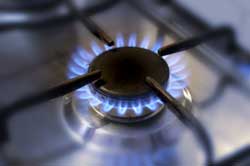
When free of clogs, flames will be blue and even.
The Oven and Stove
Energy (fuel) costs from cooking can run from $50-$100 per year. Over time, a few simple changes can add up to big savings.
Clean the reflectors under the burners to reflect heat more efficiently.
Gas burners should be cleaned on a regular basis to keep food and grease from clogging ports. When free of clogs, flames will be blue and even. A yellow flame suggests the port needs to be cleaned or adjusted. The tip of the flame (hottest part) should reach the bottom of the pan.
Food cooked in ceramic or glass pans and dishes will cook at lower temperatures than those cooked in metal.
Avoid "peeking" into the oven to check on baking progress. Each time you open the door, you lose 25% of the heat.
Turn off burners during the last few minutes of cooking. The remaining heat will be enough to finishing the cooking.
Match the pot to the burner. Heat and energy are lost if the burner is bigger than the size of the pot.
If you're considering a new cook top, induction cook tops are the most efficient users of energy. They use up to 90% of the energy they produce (electric burners use about 65% and gas burners use 55%).
The Refrigerator
Believe it or not, your refrigerator can be the third largest contributor to your total energy bill. When it's time to decide whether to repair an older model, it would be wiser to invest the money into a new, more energy efficient model; you'll see an instant $75-$100 savings on your yearly electric bill. In the meantime, try these tips.
To keep your refrigerator running at peak efficiency, keep the coils on the back and bottom clean and cool. This means routine vacuuming of the condensing coils and keeping them away from external heat sources like stoves, radiators and heat vents. Leave enough space between the coils and the wall for cooling air circulate around the condensing coils.
Give gaskets the dollar bill test. Close the door on one half of a dollar bill. If it pulls out easily when tugging on it, your not getting a good seal and your gaskets may need replacing or adjusting.
Your refrigerator and freezer will perform better if kept relatively full. Make sure food items are spaced a little apart to allow air to circulate around them.
Keep temperature settings between 38ºF and 40º F in the refrigerator, and 5ºF in the freezer (stand alone freezers should be kept at 0ºF).
Keep humidity down by keeping liquids covered and make sure hot foods are allowed time to cool before storing.
The Garbage Disposal
Running cold water while operating your garbage disposal will save energy on water heating. Use hot water only when necessary to wash away small amounts of grease.
The Dishwasher
If your dishwasher has an automatic air-dry setting, turn it off. Letting dishes air dry by opening the door can reduce a dishwasher's energy use by half. Use a good quality dishwasher detergent to prevent spots.
Pre-rinse your dishes (using cold water) before loading the dishwasher and only run when you have a full load. Run you dishwasher in the energy savings mode if you have one, and use cold water for the rinse cycle.
The Water Faucet
If you have a leaky faucet, fix it. It can usually be done for the price of a couple of washers, but a slow drip (especially hot water) can cost $35-$40 per year.
Consider attaching a low-flow aerator to your kitchen faucet. They reduce the amount of water you use without producing a noticeable difference in water flow. They are easy to install, cost from $1 to $5 dollars and will help lower your water bill and water heating costs.
The Microwave
Microwaves use as little as half the amount of energy of a conventional oven, so use them in place of conventional stoves and ovens whenever possible. Other advantages include the fact that they produce less of a build up of radiant heat in the kitchen during warm weather and they provide the most efficient means of reheating, cooking small portions and defrosting food.
Other Appliances
Turn off and unplug appliances when not in use or when you're planning on being away from home for a few days.
As old appliances wear out or break down, replace them with energy efficient models like Energy Star® appliances.
Task Lighting
Utilize task lighting in the kitchen whenever possible and replace burned out bulbs with energy efficient compact fluorescent light bulbs.
With the rising cost of some forms of energy, depleting resources, and continued pollution you may want to look at ways you can save energy. There are a number of easy to follow suggestions on this page.